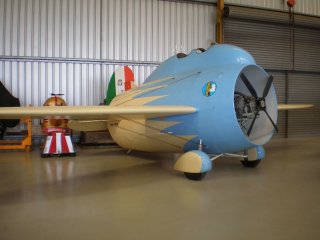Meet the Stipa-Caproni: Italy’s Bizarre “Flying Barrel” (The First 'Jet'?)
Did it help invent the jet plane?
The Stipa-Caproni was an experimental airplane designed by the Italian aeronautical engineer and aircraft designer Luigi Stipa, and built by Caproni, an Italian aircraft manufacturer. Despite looking like a cartoon air plane, the Stipa-Caproni could fly, and was briefly studied by NASA.
Italian Aeronautics
In 1932, the Italian Fascist government wanted to showcase the success of Italian technology, and in particular advances in domestic aviation. The government was petitioned by Luigi Stipa to fund the research and development of the Stipa-Caproni airplane. Stipa’s design was highly unusual, both in looks and in construction. His plane was essentially a giant tube with a propeller on the front and was made mostly of wood and canvas.
Stipa’s tube design was open at the front and the back, and narrowed in the middle in order to compress air pushed inward by the propeller, to increase efficiency. A pair of wings were mated to the middle of the tube, which also acted as a fuselage. The pilot was seated in a cockpit for two in a tandem arrangement atop the fuselage. The cockpit was not ideal, as pilot’s line of sight was hampered by humped surfaces at front and rear which restricted ground views during landing or taking off.
Compared to planes of that time with a similar engine rating, Stipa’s design was in some way superior. It could climb faster than other planes and was very stable in flight. The tail assembly was built at the back of the fuselage and interacted with the propeller’s slipstream. Some test pilots said it was too stable, and it was difficult to get the airframe to change course, though the design’s very low and controllable landing speed was praised. It also had the added benefit of being quieter than most other planes.
Stipa’s design did have some drawbacks, however. The tubed propeller suffered from high drag, which negated the other aerodynamic advantages his design benefited from. Ultimately his design did not offer any real advantages over other contemporary aircraft and the design was abandoned.
Later Years
Buoyed by the Italian government funding of his project, and interest in his work from the Italian aeronautics community, Stipa patented his design in Italy, the United States, and Germany. His oddball design was even picked up and studied by the National Advisory Committee for Aeronautics, or NACA, the precursor to NASA.
After the Second World War, Stipa was convinced that the jet engine owed its development to his design and remained bitter about not receiving recognition. He also firmly believed that the German V-1 rocket engine from World War II was created in violation of his patented design, though the rocket used a radically different design that was powered by controlled explosions rather than a propeller. Some aeronautical historian do see similarities between Stipa’s tubed propeller design and turbofan engines, partially vindicating Stipa and his design.
Caleb Larson holds a Master of Public Policy degree from the Willy Brandt School of Public Policy. He lives in Berlin and writes on U.S. and Russian foreign and defense policy, German politics, and culture.
Image: Flickr

